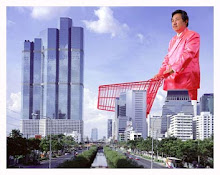April 16, 2010
Seeing what we don't want to see
The excerpt below was posted on April 8 before the violence of April 10, and contained a discussion of the way commentators have chosen to put political slogans above analysis. I've re-posted it because I think an important debate has to be had about the way academics have engaged with events in Thailand over the last four years. As I outlined in the original post, I believe that easy assumptions were made about PAD because its politics were reactionary and objectionable, and in the influential world of rumour that is the blogosphere, prejudice was heaped up prejudice to create particular images that suited political agendas or biases. Many of the things that were said about PAD could be said about UDD (if news and pictures are taken selectively), but they will not be said for the simple reason that its politics are understandably sympathetically received among commentators. There was hardly any critical discussion about UDD over the last three years other than it was a misrepresented movement of the rural poor etc etc. Such casual representations have left people unprepared for unpacking the role of different factions within the UDD and their competing agendas.
Who could disagree with UDD's official calls for more democracy and an end to amat? That is easy. But understanding what UDD is, and its relation to alternative centres of power, and indeed to old power cliques is harder. ANd understanding to what extent it is transformative, or rhetorical is difficult to ascertain. Also the class composition has largely been assumed, but the early anti-coup movement that provides some of the key cadre for UDD today was Bangkok middle class. And so it goes - there are lots of questions to consider, despite the undeniable fact of the UDD's emergence as a genuine movement of people who rightly feel disenfranchised.
*****************************
"Before the beginning of the current round of protests the UDD disowned militant elements (Sae Daeng among others) that wished to displace the current UDD leadership in order to pursue a more aggressive approach. Such forces it may be speculated were possibly behind some of violence inflicted on the yellow protests in 2008.
Since the protests began, a systematic campaign of targeted attacks (around 20 so far) on government and political buildings has been unleashed as if to demonstrate the viability of an armed path should the current campaign of civil disobedience fail. No doubt it signals to military elements relative impunity for courses of action contrary to government direction. Of course the convenient third hand can be invoked as being behind the bombings, as it was in the assault on the prime minister’s car during the Songkran demonstrations, but the logic of such a claim is weak.
This bifurcation of red shirt (not specifically the United Front for Democracy against Dictatorship) strategy, if that is what it is, is hardly commented on by those who now see the reds as the hope of the future and support calls for an immediate election so that a pro-red (and pro-Thaksin) government would come to power (probable but not certain). But the campaign of bombing points at least to one possible unpleasant future should the current government fall. Any new government will have a place for all the old elements of the bureaucratic-aristocratic elite (if we take the bureaucratic-aristocratic elite to be a broad class and not a clique) as long as they are on the right side.
Any campaign of double standards needs to be just that, and whatever the outcome of this current fight, the barracks against double standards shouldn't be dismantled too quickly."
Who could disagree with UDD's official calls for more democracy and an end to amat? That is easy. But understanding what UDD is, and its relation to alternative centres of power, and indeed to old power cliques is harder. ANd understanding to what extent it is transformative, or rhetorical is difficult to ascertain. Also the class composition has largely been assumed, but the early anti-coup movement that provides some of the key cadre for UDD today was Bangkok middle class. And so it goes - there are lots of questions to consider, despite the undeniable fact of the UDD's emergence as a genuine movement of people who rightly feel disenfranchised.
*****************************
"Before the beginning of the current round of protests the UDD disowned militant elements (Sae Daeng among others) that wished to displace the current UDD leadership in order to pursue a more aggressive approach. Such forces it may be speculated were possibly behind some of violence inflicted on the yellow protests in 2008.
Since the protests began, a systematic campaign of targeted attacks (around 20 so far) on government and political buildings has been unleashed as if to demonstrate the viability of an armed path should the current campaign of civil disobedience fail. No doubt it signals to military elements relative impunity for courses of action contrary to government direction. Of course the convenient third hand can be invoked as being behind the bombings, as it was in the assault on the prime minister’s car during the Songkran demonstrations, but the logic of such a claim is weak.
This bifurcation of red shirt (not specifically the United Front for Democracy against Dictatorship) strategy, if that is what it is, is hardly commented on by those who now see the reds as the hope of the future and support calls for an immediate election so that a pro-red (and pro-Thaksin) government would come to power (probable but not certain). But the campaign of bombing points at least to one possible unpleasant future should the current government fall. Any new government will have a place for all the old elements of the bureaucratic-aristocratic elite (if we take the bureaucratic-aristocratic elite to be a broad class and not a clique) as long as they are on the right side.
Any campaign of double standards needs to be just that, and whatever the outcome of this current fight, the barracks against double standards shouldn't be dismantled too quickly."





